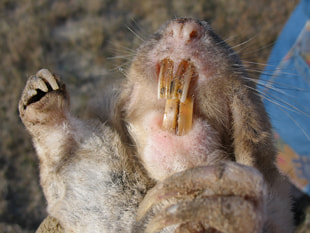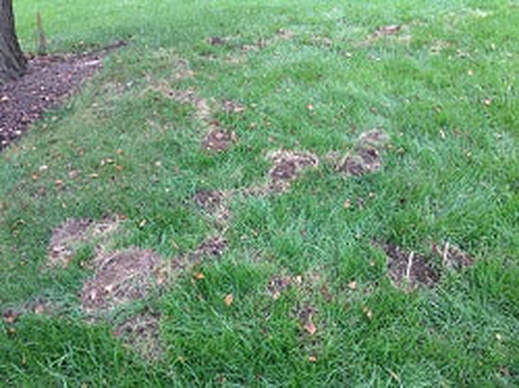 Few creatures are hated by homeowners and agriculturists as much as moles and gophers. Their underground excavations create mounds of excess dirt that has to go somewhere, so they push it out of the burrow and make unsightly mounds in the middle of the lawn or landscaping. Moles and gophers are often lumped together, but in reality, they are very different animals. Other than they both dig in the yard or garden where we don't want them to, they really have very little in common. GophersThere are 13 species of gophers in the US, but the one most commonly found in Oklahoma is the Plains Pocket Gopher (Geomys bursarius). There is, however, a localized population of Mexican Pocket Gophers (Cratogeomys castanops) found in the Oklahoma panhandle region. Gophers are strictly vegetarians. The eat the roots and young shoots of plants chewing them off at the surface from below. They can cause a lot of damage in a garden and are hated by gardeners. Gophers dig deep tunnels. The only evidence that they are present is the unsightly, crescent shaped mounds of dirt that push up out of their tunnels. Below the surface is a complex network of connected chambers, storerooms, and a drainage system that would be the envy of any engineer. Gophers also have another unique adaption in that their skin closes BEHIND their teeth. This allows them to chew through the dirt without getting dirt in their mouth!
There a seven species of moles in the US, but in Oklahoma, we only have the Eastern Mole, (Scalopus aquaticus) Moles are strictly carnivores. They dig long tunnels just below the surface in search of earthworms, grubs, etc. The do not damage the grass or plants by eating their roots as gophers do, but rather dislodge them while digging tunnels in search of food. On an average day, a mole will eat 60-90% of its own bodyweight in earthworms, grubs and insects. Moles create a nest under a sidewalk, tree, driveway, or other hard surface. They make deep tunnels that they use to move from place to place, especially from the nest to the feeding grounds. These tunnels are 6-12" deep and usually run along a hard surface such as a retaining wall or sidewalk. These deep tunnels are used daily and may be used for years. However, once they get to their feeding grounds, they move up to just below the surface and create shallow tunnels. Rather than digging the dirt out of a feeding tunnel, they simply push the dirt upwards to create the classic "mole tunnel". Shallow mole runs may be used once and never used again, or if the hunting is good, may be reused several times as long as they are finding food.
|
AuthorMark Runnels is a professional engineer and owner of Predator Impact, LLC. Archives
May 2024
Categories |






 RSS Feed
RSS Feed